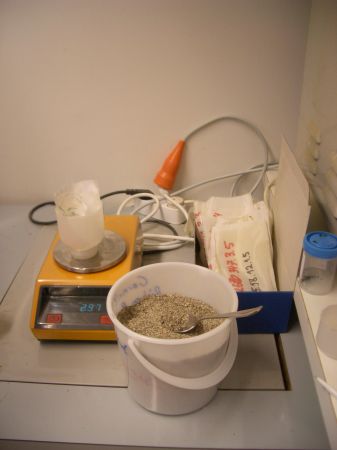The data can be used as the basis of the CNCPS under Austrian feeding conditions. The in-situ technique is a very valuable and absolutely necessary method for characterizing feed, which is why the degradation parameters of the nutrients in the rumen should be available for the most important basic and concentrated feed.
In the new feed evaluation systems (e.g. AFRC 1993, FOX et al. 2000 (CNCPS), NRC 2001) the classic Weender analysis is increasingly being replaced by more extensive analyses. The main reason is that the Weender analysis does not describe the carbohydrates in accordance with the digestive physiological conditions and, moreover, the raw nutrients “crude fiber” and “N-free extractives” do not correspond to chemical substance groups (Van SOEST 1994, NRC 2001).
A more accurate separation of the carbohydrates occurs via the so-called detergent analysis of the cell wall components according to van SOEST (NDF, ADF, ADL), from which the framework carbohydrates cellulose, hemicellulose and lignin can be calculated. In addition, the non-structural carbohydrates (especially sugar and starch, pectin, organic acids) can be determined indirectly by subtracting the NDF as well as crude protein, crude fat and crude ash from the total dry matter (Van SOEST 1994, FOX et al. 2000, NRC 2001).
Structural and non-structural carbohydrates influence the pH value in the rumen differently via saliva production and thus create the optimal conditions for their fermentation by the rumen microbes. As a result, predominantly acetic acid is formed from the structural carbohydrates and mainly propionic acid is formed from the non-structural carbohydrates. These two main products of rumen metabolism perform completely different functions in the metabolism of the host animal, namely acetic acid as a starting substance for fat synthesis and propionic acid as a starting substance for gluconeogenesis and thus the energy supply of the host animal. In addition, acetic and propionic acid bacteria differ significantly in their efficiency of microbial protein synthesis (RUSSEL et al. 1992). It can be concluded from this that the nutrient analysis used in the CORNELL system (FOX et al. 2000) is very well founded in terms of digestive physiology. Therefore, the content of the nutrient fractions of the CORNELL system should also be determined in the most important basic and concentrated feed used in Austria.
The Cornell Net Carbohydrate and Protein System (CNCPS) distinguishes 4 carbohydrate and 5 protein fractions. The basis for the assignment to the fractions is the rate of breakdown of nutrients in the rumen (Sniffen et al. 1992, Fox et al. 2000):
4 carbohydrate fractions: A, B1, B2, C
Nonstructural carbohydrates:
A: sugar
B1: starch
Structural carbohydrates:
B2: Available structural carbohydrates
C: Unavailable structural carbohydrates
5 protein fractions: A, B1, B2, B3, C
A: Non-protein nitrogen (NPN), immediately and completely available
B1: Rapidly degradable, soluble protein
B2: Protein with medium degradation rate
B3: Slowly degradable protein
C: Not available N bound to the cell wall
Another important piece of information about feed value is the extent and speed of nutrient breakdown in the rumen. The so-called in-situ method has been used for years to determine these parameters (including NOCEK 1988, ORSKOV & RYLE 1990, MERTENS 1993, MADSEN & HVELPLUND 1994, HUNTINGTON & GIVENS 1995). In almost all modern protein assessment systems, the proportion of feed protein that is not broken down in the rumen is determined using the in-situ method (INRA 1989, AFRC 1993, FOX et al. 2000 (CNCPS), NRC 2001 etc., with the exception of GfE 2001). In addition, a close relationship between nutrient degradation in the rumen (determined using the in situ method) and feed intake has been demonstrated (HOVELL et al. 1986, ORSKOV et al. 1988, CARRO et al. 1991, BLÜMMEL & ORSKOV 1993, KHAZAAL et al. 1995, CHERMITI et al. 1996, FERRET et al. 1997, DAWSON & STEEN 2000). In addition, the degradation rates of the protein and carbohydrates also allow a statement to be made about the temporal availability (synchronism) of these nutrients for the rumen microbes over the course of the day (SINCLAIR et al. 1993 and 1995, BLANK et al. 1998, DLG 2001, FOX et al. 2001) . The degradation kinetics is often described using the equation from ORSKOV & McDONALD (1979):
"deg" = a + b * (1 - exp(-c * t))
The in-situ technique is therefore a very valuable and almost necessary method for characterizing feed for several reasons, which is why relevant values should be available for the most important basic and concentrated feed used in Austria.
Further information on project management can be found in the database for research and sustainable development (Dafne) -> Link







